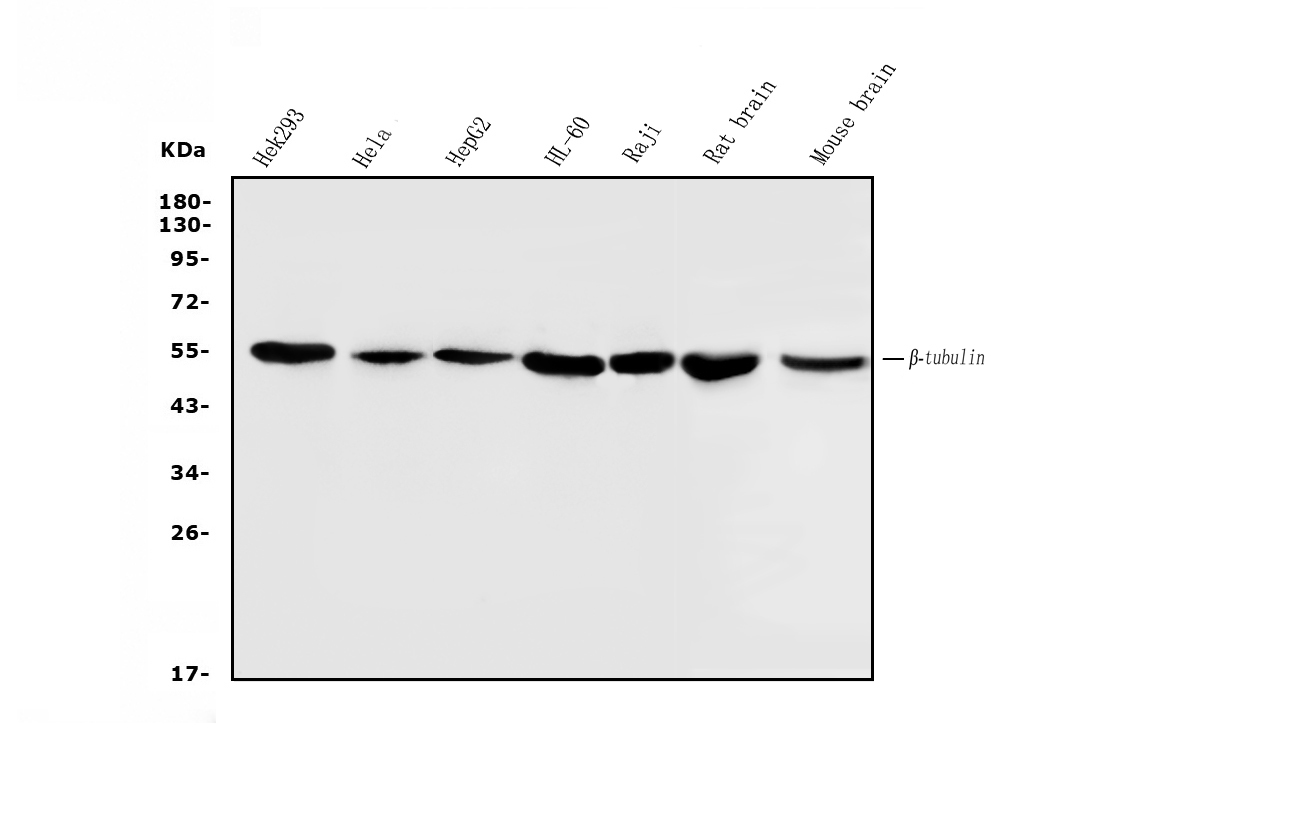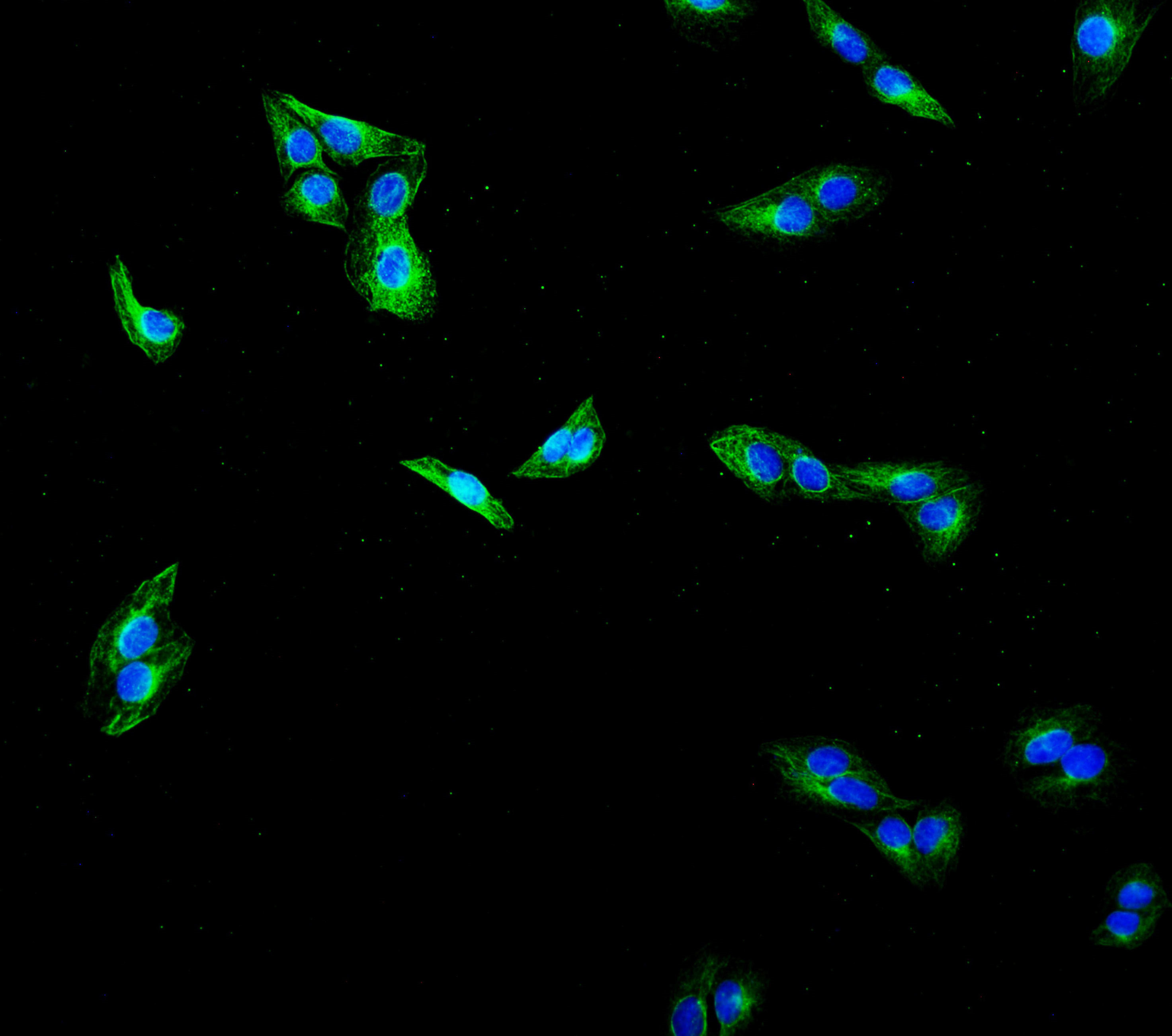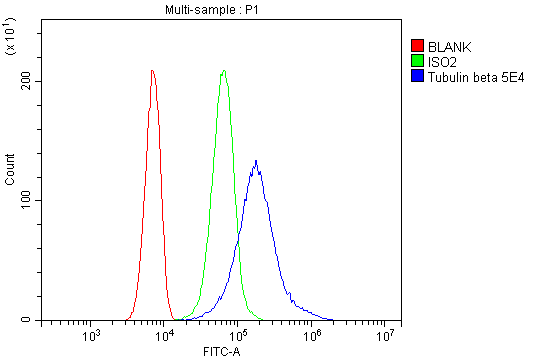| Western blot (WB): | 1:500-2000 |
| Immunocytochemistry/Immunofluorescence (ICC/IF): | 1:50-400 |
| Flow Cytometry (Fixed): | 1:50-200 |

Western blot analysis of Beta Tubulin/TUBB using anti-Beta Tubulin/TUBB antibody (M01857-3). The sample well of each lane was loaded with 30 ug of sample under reducing conditions.
Lane 1: human HEK293 whole cell lysates,
Lane 2: human HELA whole cell lysates,
Lane 3: human HepG2 whole cell lysates,
Lane 4: human HL-60 whole cell lysates,
Lane 5: human Raji whole cell lysates,
Lane 6: rat brain tissue lysates,
Lane 7: mouse brain tissue lysates.
After electrophoresis, proteins were transferred to a membrane. Then the membrane was incubated with mouse anti-Beta Tubulin/TUBB antigen affinity purified monoclonal antibody (M01857-3) at a dilution of 1:1000 and probed with a goat anti-mouse IgG-HRP secondary antibody (Catalog # BA1050). The signal is developed using ECL Plus Western Blotting Substrate (Catalog # AR1197). A specific band was detected for Beta Tubulin/TUBB at approximately 55 kDa. The expected band size for Beta Tubulin/TUBB is at 50 kDa.

IF analysis of Beta Tubulin/TUBB using anti-Beta Tubulin/TUBB antibody (M01857-3).
Beta Tubulin/TUBB was detected in an immunocytochemical section of A431 cells. The section was incubated with mouse anti-Beta Tubulin/TUBB Antibody (M01857-3) at a dilution of 1:100. Dylight488-conjugated Anti-mouse IgG Secondary Antibody (green)(Catalog#BA1126) was used as secondary antibody. The section was counterstained with DAPI (Catalog # AR1176) (Blue).

Flow Cytometry analysis of SiHa cells using anti-Beta Tubulin/TUBB antibody (M01857-3).
Overlay histogram showing SiHa cells stained with M01857-3 (Blue line). To facilitate intracellular staining, cells were fixed with 4% paraformaldehyde and permeabilized with permeabilization buffer. The cells were blocked with 10% normal goat serum. And then incubated with mouse anti-Beta Tubulin/TUBB Antibody (M01857-3) at 1:100 dilution for 30 min at 20°C. DyLight®488 conjugated goat anti-mouse IgG (BA1126) was used as secondary antibody at 1:100 dilution for 30 minutes at 20°C. Isotype control antibody (Green line) was mouse IgG at 1:100 dilution used under the same conditions. Unlabelled sample without incubation with primary antibody and secondary antibody (Red line) was used as a blank control.

Western blot analysis of Beta Tubulin/TUBB using anti-Beta Tubulin/TUBB antibody (M01857-3). The sample well of each lane was loaded with 30 ug of sample under reducing conditions.
Lane 1: human HEK293 whole cell lysates,
Lane 2: human HELA whole cell lysates,
Lane 3: human HepG2 whole cell lysates,
Lane 4: human HL-60 whole cell lysates,
Lane 5: human Raji whole cell lysates,
Lane 6: rat brain tissue lysates,
Lane 7: mouse brain tissue lysates.
After electrophoresis, proteins were transferred to a membrane. Then the membrane was incubated with mouse anti-Beta Tubulin/TUBB antigen affinity purified monoclonal antibody (M01857-3) at a dilution of 1:1000 and probed with a goat anti-mouse IgG-HRP secondary antibody (Catalog # BA1050). The signal is developed using ECL Plus Western Blotting Substrate (Catalog # AR1197). A specific band was detected for Beta Tubulin/TUBB at approximately 55 kDa. The expected band size for Beta Tubulin/TUBB is at 50 kDa.

IF analysis of Beta Tubulin/TUBB using anti-Beta Tubulin/TUBB antibody (M01857-3).
Beta Tubulin/TUBB was detected in an immunocytochemical section of A431 cells. The section was incubated with mouse anti-Beta Tubulin/TUBB Antibody (M01857-3) at a dilution of 1:100. Dylight488-conjugated Anti-mouse IgG Secondary Antibody (green)(Catalog#BA1126) was used as secondary antibody. The section was counterstained with DAPI (Catalog # AR1176) (Blue).

Flow Cytometry analysis of SiHa cells using anti-Beta Tubulin/TUBB antibody (M01857-3).
Overlay histogram showing SiHa cells stained with M01857-3 (Blue line). To facilitate intracellular staining, cells were fixed with 4% paraformaldehyde and permeabilized with permeabilization buffer. The cells were blocked with 10% normal goat serum. And then incubated with mouse anti-Beta Tubulin/TUBB Antibody (M01857-3) at 1:100 dilution for 30 min at 20°C. DyLight®488 conjugated goat anti-mouse IgG (BA1126) was used as secondary antibody at 1:100 dilution for 30 minutes at 20°C. Isotype control antibody (Green line) was mouse IgG at 1:100 dilution used under the same conditions. Unlabelled sample without incubation with primary antibody and secondary antibody (Red line) was used as a blank control.


